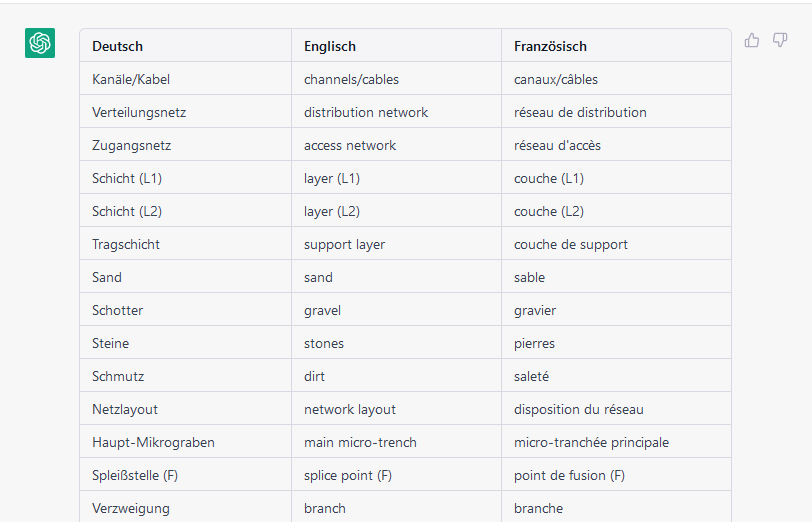My dear colleague (and former student) Florian Pfaffelhuber just drew my attention to the fact that ChatGPT is great at multilingual terminology extraction. It can also handle more than two languages and will create very nice multilingual glossary tables for you.
What worked best when we tested it today was to copy the prompt and the respective texts into one message for ChatGPT, i.e. not submit the prompt and then send the text corpora in separate successive messages. I put the different bits together in a Word document and then copied everything into the message field in one go. The texts we used for testing were sets of claims from European patents that we just copied out of the PDF patent specifications. This is why we told ChatGPT to include the reference signs, to make sure it picked the essential terms.
These are the prompts we used:
In English:
Please extract the technical terms from the following text and list them in a table in German, English and French. Please also include all terms that stand in front of a reference sign (reference signs are the numbers in brackets). Please also include the reference signs in the table.
In German:
Bitte extrahiere aus folgendem text die Fachtermini und liste sie mir in einer Tabelle auf Deutsch, Englisch und Französisch. Bitte schließe auch alle Begriffe mit ein, die vor einem Bezugszeichen stehen (Bezugszeichen sind die Zahlen in Klammern). Bitte übernimm auch die Bezugszeichen in die Tabelle.
***
Addendum [April 20, 2023]: After some further experimenting, it turned out that ChatGPT can be very “creative” from time to time and adds terms to the glossary randomly that do not occur at all in the respective text. Here is another prompt that seemed to overcome this problem:
I have a text in two languages. Please create a bilingual glossary containing exclusively the terms from this text. This is the text:
All in all, it is important to bear in mind that ChatGPT or any AI does not work like a software tool, which is based on rules and programmed to perform predefined tasks. ChatGPT may respond to the same prompt differently each time you use it.
***
This is what the result looks like using the first prompt:
| Deutsch | Englisch | Französisch |
| Kanäle/Kabel | channels/cables | canaux/câbles |
| Verteilungsnetz | distribution network | réseau de distribution |
| Zugangsnetz | access network | réseau d’accès |
| Schicht (L1) | layer (L1) | couche (L1) |
| Schicht (L2) | layer (L2) | couche (L2) |
| Tragschicht | support layer | couche de support |
| Sand | sand | sable |
| Schotter | gravel | gravier |
| Steine | stones | pierres |
| Schmutz | dirt | saleté |
| Netzlayout | network layout | disposition du réseau |
| Haupt-Mikrograben | main micro-trench | micro-tranchée principale |
| Spleißstelle (F) | splice point (F) | point de fusion (F) |
| Verzweigung | branch | branche |
| Anschluss | connection | connexion |
| Endziel | end target | cible finale |
| Fräsen | milling | fraisage |
| Fräsmaschine | milling machine | fraiseuse |
| Diamantfräsblatt | diamond milling blade | lame de fraisage au diamant |
| Gegenlauffräsen | counter-rotational milling | fraisage contre-rotatif |
And here you can see ChatGPT at work:
ARVE error: Invalid URL in mp4
ARVE error: detect_provider_and_id_from_url method needs url.
And how does ChatGPT make your life easier? Feel free to share your experience, tips, and tricks in the comments 🙂
About the author
Anja Rütten is a freelance conference interpreter for German (A), Spanish (B), English (C), and French (C) based in Düsseldorf, Germany. She has specialised in knowledge management since the mid-1990s.
She is a full member of AIIC, an accredited freelance interpreter with the EU institutions and the European Patent Office, and has vast experience as a university lecturer.
Contents

Leave a Reply to Anja RüttenCancel reply